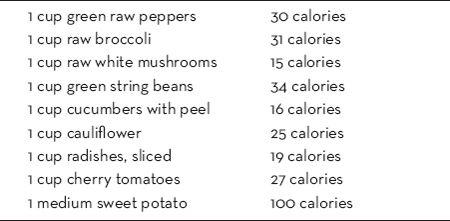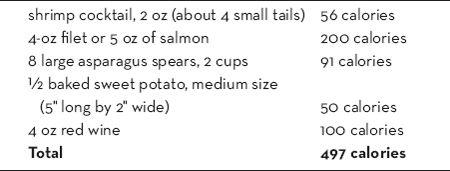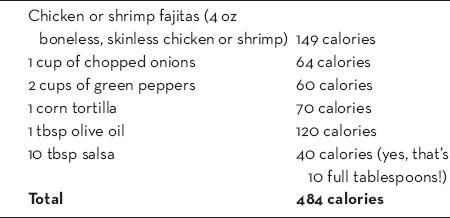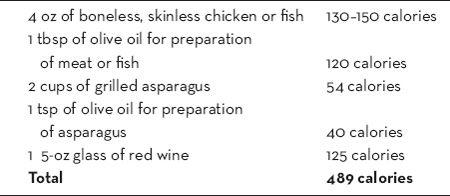The Petite Advantage Diet (22 page)
Read The Petite Advantage Diet Online
Authors: Jim Karas

When eating lunch out (or in, for that matter), I
really
want you to avoid anything with mayonnaise, and that includes all tuna, chicken, and egg salad. Mayo is a lethal member of the Addies family. I’ve had struggling Petites tell me for years that they ate “light” and had a tuna fish sandwich. I almost needed oxygen. But I really don’t blame them, as they were raised to believe that salads like these were diet foods. Sorry, but they were misinformed. Again, mayo is a highly caloric member of the Addies group and needs to be used very sparingly. If you can find a lower-calorie mayo or spread and use it in a portion-controlled manner, then that is fine. I have found that these are hard to find in the stores these days, so that is why I didn’t include that option in the first place.
Dinner
For dinner, you can eat four to six ounces of protein (approximately 120 to 300 calories). Choose your portion and calorie count from the previous charts. To this, you can add three to five cups of vegetables chosen from the chart below.

I want you to avoid rice in restaurants (with the exception of sushi, which I will explain later in this chapter), as it is always prepared with a lot of Addies like oil, butter, margarine, or other fat and that makes it very high in calories.
Let me break down what I consider to be the five components of dinner:
1.
Bread. Note that this is
not
dipped in Addies. It’s just plain old bread, hopefully whole-wheat or whole-grain, and also not Italian focaccia bread, which is “white”
and
loaded in oil, the king of Addies.
2.
Appetizer. Make sure this is truly the size of an appetizer, not an entrée, and is absolutely not fried, filled with cream, or made in a phyllo-type dough.
3.
Main course. An appropriate-size combination of lean protein, veggies, the right fats, and a “slow” carb.
4.
Dessert. This is sorbet, not double-chocolate mocha cream-stuffed pie with crème fraîche.
5.
Wine. Maximum 10 ounces–that means two 5-ounce glasses.
Here is how your restaurant dinner will affect your weight-loss plan. Be honest. Which of these sounds like you?
1
of the 5 components = a weight-loss day. Note that that can be the entrée with vegetables, fat, and the right “slow-release” carb
.
2
of the 5 components = a weight-maintenance day. Note that if it’s only one glass of wine instead of two, then it would fall into the weight-loss-day category
.
3
of the 5 components = a slight overage of calories that can easily be burned off the next day by extra-careful calorie-counting
.
4
of the 5 components = a larger overage of calories that will require three to five days of even more rigid calorie-counting plus potential added exercise
.
5
of the 5 components = This alone may be the reason why you continue to gain weight
.
Once again, I can just hear you saying: “Jim Karas just won’t let me eat anything! He is spoiling all my fun.” That’s not true. My goal here is to help you and teach you to undo many of the not-so-great habits you have befriended in the past. Yes, I want you to have fun, but I also want you to succeed at this quest. Living “lean” is really
fun
. Just wait until you taste it. Trust me; it’s amazing.
Eating Out Intelligently
Part of my goal in this chapter on eating out is to help you recalibrate your belief system and your vision of eating out. I can help you make it a great experience without suffering undue caloric damage. Once you get into this new “habit,” you will be surprised at how easy it is to embrace. Since dinner is the most frequent meal eaten out in a restaurant, I want to tell you explicitly what to order in the most popular types of restaurants.
Steak houses
I
love
steak houses. Most Petites are shocked to hear me say that, if I had my way, you would eat every meal outside of your home in a steak house. Why? Because you don’t have to play the “Avoid the Addies” game, as most food prepared in a steak house can be prepared “clean.” When I use the word “clean,” I mean prepared with little or no Addies. It’s just great-quality, great-tasting food in its most natural state, with wonderful spices to enhance, not overwhelm, the taste. Your dinner at a steak house should include:

This is
perfect
for your 1600-calorie-day dinner.
Petite busters:
Portions. Steak houses are known for huge portions, so have your eyes finely tuned to the size of each dish that is coming to the table.
Mexican Restaurants
Mexican restaurants can be a great choice, if you avoid some obvious pitfalls. Here is what I want you to order and I will follow that with what I want you to avoid. Your dinner at a Mexican restaurant should include:

This is
perfect
for your 1600-calorie-day dinner. And please, add lots of spices–cayenne pepper, red pepper chili flakes, or anything else spicy that you love.
Petite busters:
Guacamole and the chips on the table. While avocado contains the “good” fat, it is a platinum member of the Addies and a little goes a long way. The chips on the table are deep-fried and packed with calories. Also, the rice and beans, while excellent if homemade with the right whole-grain or brown rice, are prepared with a tremendous amount of fat in restaurants and, therefore, are to be avoided.
Italian Restaurants
You probably already know that Italian restaurants are the most popular restaurants in the United States. This is good for the Italian restaurant owners and bad for your daily caloric intake, especially if you are a Petite. Italian food is
very
difficult to manage in a restaurant. Here is your best bet:

This is
perfect
for your 1600-calorie-day dinner.
Petite busters:
I need to take these one at a time since they each present their own issue when it comes to Petites eating in Italian restaurants.
• Bread. Most big, thick, Italian restaurant bread is a deal-breaker when it comes to a low-calorie meal. Similar to liquid calories (which I will address in chapter 7), if Americans would give up restaurant bread, our obesity epidemic would quickly flame out–at least somewhat. Most bread, especially the bread in Italian restaurants, is a caloric killer and, as I mentioned before, all white bread is a “quick empty” item.
• Olive oil. Back in the late 1980s, dipping your bread in olive oil became popular. That’s a real disaster, as olive oil possesses more calories than butter (surprised?) and you just heard my opinion on bread. Everyone also assumed that, since olive oil is considered “healthy,” you can eat as much of it as you want. I introduced you to my saying “Shine and glimmer won’t make you slimmer” and the shine on your food in an Italian restaurant indicates just one thing–oil. If you find an Italian restaurant that will prepare your food the way you want it, I say great. Go there whenever you get a craving for it. But in general, just know that Italian restaurants are going to pose a potential problem when it comes to the calories you plan to consume.
I had a well-known writer in New York City as a client
.
She was truly very good about her choices, portions, snacking, etc. She had only one major flaw; all her vegetables were prepared in oil, whether she was eating out or at home. Look, veggies are a terrific choice for many reasons, one of them being the fact that they are
so
high in water content. But when you cook veggies in oil, much of the wonderful water flies out and the unnecessary oil sucks itself in. That turns fifty calories of steamed spinach into 290 calories of spinach sautéed in olive oil. How did I arrive at that number? Olive oil (and all oil, for that matter) is 120 calories a tablespoon and 100 percent fat. Take two tablespoons in a saucepan, sauté the spinach, and presto, you just added 240 calories to the fifty-calorie spinach, for a total of 290 calories
.
• Pasta. This one has to be avoided when eating out. It is all covered with Addies and the pasta alone is approximately 225 calories a cup. If eaten at home, without adding fat to the noodles, you should be fine. But in a restaurant, there is no way they will serve it to you without a great deal of added fat. Two tablespoons alone will make that one cup of pasta equal 465 calories. That’s all you will get for your entire dinner–no fruits or vegetables, just simple carbs and fat. Not my recommendation for dinner.
Chinese Restaurants
Like Italian restaurants, Chinese eateries present a challenge. Not only is most of the food fried, but it is also frequently prepared in a lot of high-calorie sauce. Here is what I recommend:

